Click on images to enlarge
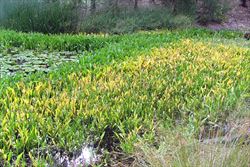
large infestation (Photo: Sheldon Navie)
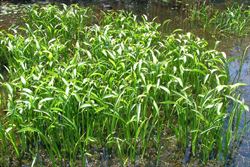
infestation (Photo: Sheldon Navie)
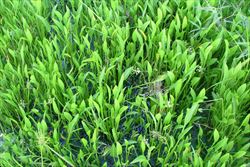
infestation (Photo: Sheldon Navie)
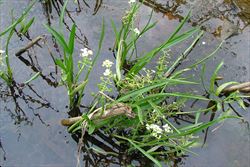
habit with narrower leaves (Photo: Sheldon Navie)
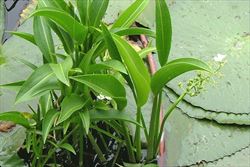
habit with broader leaves (Photo: Sheldon Navie)
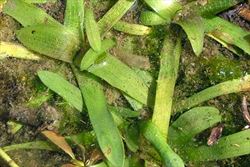
the strap-like submerged leaves on young plants (Photo: Sheldon Navie)
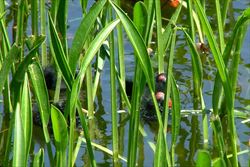
elongated emergent leaves (Photo: Sheldon Navie)
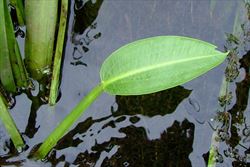
broader emergent leaf borne on a thick three-angled stalk (Photo: Sheldon Navie)
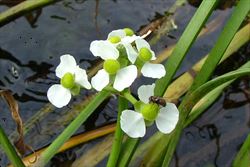
female flowers with green centres made up of numerous carpels (Photo: Sheldon Navie)
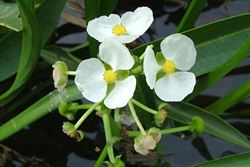
male flowers with yellow stamens (Photo: Sheldon Navie)
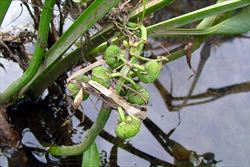
immature fruit (Photo: Sheldon Navie)
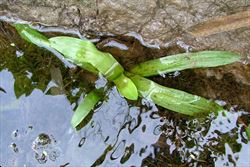
young plant (Photo: Sheldon Navie)
Scientific Name
Sagittaria platyphylla (Engelm.) J.G. Sm.
Synonyms
Sagittaria graminea Michx.Sagittaria graminea Michx. subsp. platyphylla Engelm.Sagittaria graminea Michx. var. platyphylla Engelm.Sagittaria graminea Michx. var. weatherbiana (Fernald) BoginSagittaria weatherbiana Fernald
Family
Alismataceae
Common Names
arrow-head, arrowhead, delta arrowhead, grassy arrowhead, sagittaria, slender arrowhead
Origin
Native to eastern USA (i.e. Ohio, Pennsylvania, West Virginia, Illinois, Missouri, Oklahoma, Alabama, Arkansas, Florida, Georgia, Kentucky, Louisiana, Mississippi, Tennessee and Texas), Mexico and Central America (i.e. Panama).
Cultivation
Sagittaria (Sagittaria platyphylla) is sometimes grown as an ornamental plant in garden ponds and water features.
Naturalised Distribution
This species is widely naturalised, but scattered, in southern and easatern Australia. It is most common in the irrigation areas of northern Victoria and southern New South Wales. Also becoming common in the coastal districts of New South Wales and Queensland, and present in south-eastern South Australia and south-western Western Australia. Was previouslynaturalised in the ACT, but has not been recorded there in the last 30 years.
Habitat
A weed of waterways, marshes, swamps, drainage ditches, irrigation channels and rice crops in warmer temperate, sub-tropical and tropical environments.
Habit
A long-lived (i.e. perennial) aquatic herbaceous plant usually rooted to the ground with stems and leaves emerging up to 80 cm above the water surface. However, plants may sometimes become detached from the substrate form floating mats of vegetation on or near the water surface.
Distinguishing Features
- an aquatic herbaceous plant rooted to the ground with stems and leaves emerging above the water surface.
- its large elongated leaves (10-48 cm long and 2-10 cm wide) and borne on long three-sided stalks.
- separate male and female flowers are borne in groups of three on the emergent flowering stems.
- the lower flowers in each cluster are female while the slightly larger upper flowers are male.
- these flowers (about 30 mm across) are white or sometimes pinkish in colour with three sepals and three petals.
Stems and Leaves
The upright (i.e. erect) flowering stems are produced above the water surface and creeping underground stems (i.e. rhizomes) are also produced in the substrate.
Two distinct types of leaves are also produced by this species. The emergent leaves are large (10-48 cm long and 2-10 cm wide) and borne on long stalks (i.e. petioles) up to 55 cm long. These stalks, which are up to 25 mm thick, are triangular in cross-section and are slightly winged towards the base. The leaf blades are elongated (i.e. lanceolate) or narrowly egg-shaped in outline (i.e. narrowly ovate) with entire margins and pointed tips (i.e. acute apices). They are hairless (i.e. glabrous) and have a shiny appearance. The underwater leaves are strap-like in nature (up to 50 long and 10-25 mm wide) and form a rosette below the water surface.
Flowers and Fruit
Separate male and female (i.e. unisexual) flowers are borne on the same plant (i.e. this species is monoecious). These flowers (about 30 mm across), which are white or sometimes pinkish in colour, are arranged in 2-12 groups (i.e. whorls) of three near the top of the emergent flowering stems. The lower groups of flowers are female (i.e. pistillate) and are borne on stalks (i.e. pedicels) 5-70 mm long that thicken and curve downwards (i.e. become recurved) as the fruit begin to mature. The upper groups of male (i.e. staminate) flowers are slightly larger and do not become recurved. Both types of flowers have three green sepals (3-8 mm long) and three petals (6-16 mm long). Flowering occurs mostly during summer and autumn.
The fruit consists of a mass of numerous one-seeded fruitlets (i.e. achenes) that are densely arranged in a small rounded cluster (5-15 mm across). Individual seeds are oblong in shape (1.5-3 mm long), flattened, with a small projection (i.e. beak) at one end and sometimes with one to three narrow 'wings' on their sides.
Reproduction and Dispersal
This species reproduces by seed, underground tubers (up to 40 mm long and 15 mm wide) and underground stem segments (i.e. rhizomes).
The underground stem fragments and tubers may be dispersed during floods and in dumped aquarium and garden waste. They also facilitate the lateral spread of colonies over time. The seeds are thought to be spread by water movement and animals.
Environmental Impact
Sagittaria (Sagittaria paltyphylla) is regarded as an environmental weed in Queensland, New South Wales and Western Australia, and as an emerging or potential environmental weed in other parts of southern Australia. It was recently listed as a priority environmental weed in at least one Natural Resource Management region.
Legislation
This species is declared under legislation in the following states and territories:
- New South Wales: Class 4 - a locally controlled weed. The growth and spread of this species must be controlled according to the measures specified in a management plan published by the local control authority and the plant may not be sold, propagated or knowingly distributed (in a minority of local authority areas). Class 5 - a restricted weed which must not be sold, bought or knowingly distributed (throughout the entire state). See the New South Wales Department of Primary Industries Noxious Weeds List at http://www.dpi.nsw.gov.au for more detailed information on which local areas are covered in these declarations.
- South Australia: 1@ - declared in Class 1b, a designation for established aquatic plants. The presence of this species must be notified and the plant must be destroyed (throughout the entire state). This species is declared as Sagittaria graminea in South Australia.
- Tasmania: D - the importation or sale of this species is prohibited and measures to reduce its population in an area, eradicate it from an area, or restrict it to a particular area may be required. This species is declared as Sagittaria graminea in Tasmania.
- Western Australia: P1 - trade, sale or movement into the state prevented, and P2 - to be eradicated (throughout the entire state).
Management
For information on the management of this species see the following resources:
- the Western Australian Department of Agriculture and Food information page on this species, which is available online at http://www.agric.wa.gov.au.
Similar Species
Sagittaria (Sagittaria platyphylla) may be confused with arrowhead (Sagittaria montevidensis), creeping burrhead (Echinodorus cordifolius subsp. cordifolius), water plantain (Alisma plantago-aquatica), alisma (Alisma lanceolatum) and pickerel weed (Pontederia cordata). These species can be distinguished by the following differences:
- sagittaria (Sagittaria platyphylla) has leaves with triangular stalks (i.e. petioles) and lance-shaped (i.e. lanceolate) or narrowly egg-shaped (i.e. narrowly ovate) leaf blades. Its relatively large flowers (up to 30 mm across) are white (sometimes pinkish) in colour and arranged in threes along unbranched clusters. Separate male and female flowers are present in these clusters.
- arrowhead (Sagittaria montevidensis) has leaves with round stalks (i.e. petioles) and leaf blades with two pointed lobes at the base, giving them the appearance of an 'arrow-head'. Its relatively large flowers (about 25 mm across) are predominantly white in colour and arranged in threes along unbranched or few-branched clusters. Separate male and female flowers are present in these clusters.
- creeping burrhead (Echinodorus cordifolius subsp. cordifolius) has leaves with rounded or slightly ridged stalks (i.e. petioles) and rounded or heart-shaped (i.e. cordate) bases. Its relatively large flowers (up to 25 mm across) are white and arranged in groups of 3-15 along unbranched clusters. All flowers are bisexual.
- water plantain (Alisma plantago-aquatica) has lance-shaped (i.e. lanceolate) leaves with rounded or heart-shaped (i.e. cordate) bases. Its relatively small flowers (about 10 mm across) are pale lilac or white in colour and are arranged in large much-branched clusters. All flowers are bisexual.
- alisma (Alisma lanceolatum) has lance-shaped (i.e. lanceolate) leaves with gradually narrowed bases. Its relatively small flowers (about 10 mm across) are pale lilac or white in colour and are arranged in large much-branched clusters. All flowers are bisexual.
- pickerel weed (Pontederia cordata) has heart-shaped (i.e. cordate) or somewhat lance-shaped (i.e. lanceolate) leaves with stem-clasping stalks (i.e. petioles). Its relatively small flowers (about 15 mm across) are blue or violet in colour (occasionally white) and arranged in dense elongated clusters. All flowers are bisexual.

